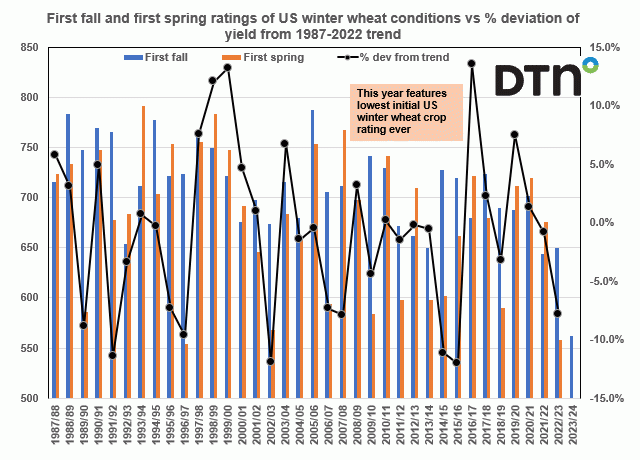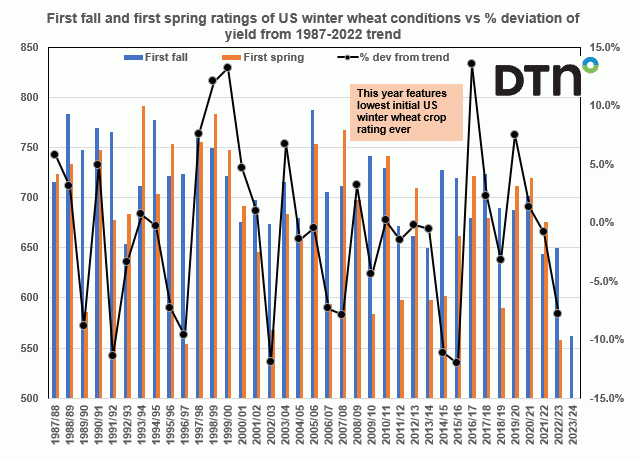Fundamentally Speaking
U.S. Winter Wheat Crop Rating Worst Ever
The USDA released its first U.S. winter wheat crop condition report for 2021/22 with just 41% of the crop rated either in the good or excellent categories compared with 56% last year.
Does this portend a lower final winter wheat yield than a year ago?
Not in the least as the correlation between the first winter wheat crop rating in the fall, which is usually furnished the last week of October, and what the final yield will be is actually negative, meaning there is no relationship at all.
This graphic shows the first fall winter wheat crop rating of the year vs. the percent that the May yield estimate deviated from the 30-year trend of the final yield.
P[L1] D[0x0] M[300x250] OOP[F] ADUNIT[] T[]
Crop conditions are measured using our usual ratings system where we weight the crop based on the percent in each category and assign that category a factor of 2 for very poor, 4 for poor, 6 for fair, 8 for good, and 10 for excellent and then sum the results.
This data goes from late October 1987 to late October 2020. We also report in the yellow circles the end of October cumulative drought ratings D1 through D4 for High Plains area of U.S which includes ND, SD, NE, KS, CO and WY.
Not all key winter wheat states are in this geographical area but Kansas, the largest wheat producing state is. Recall D1 is moderate drought, D2 is severe drought, D3 is extreme drought and D4, the worst category is exceptional drought.
This year's first fall rating came in at 644, not only well below the year ago level but is in fact the lowest initial U.S. winter wheat crop rating since the USDA started the 18-state data series back in 1987.
The abysmally low ratings are linked to severe drought conditions in much of the Plains where the bulk of the nation's hard red winter wheat crop is grown.
This is confirmed by a cumulative D1 through D4 drought reading of 71.27%
There is however a lot of time between now and when the crop is harvested in the June/July period and from what we have learned over the years is how the crop survives the dormancy period over the winter and what kind of conditions in terms of heat and moisture the plants will have to endure in the spring, especially during the critical reproductive phase are most important for yield determination.
We have seen years where a poor fall rating resulted in very good yields if spring conditions were favorable and conversely years where a high initial crop rating made no difference when winter and spring conditions were poor.
Even though this year's first crop rating is the worst ever, we see the first one for the 2013/14 season was almost as bad at a 650 rating and the High Plains area back then had an even higher percent of their land classified in some sort of drought situation at 98.20%, yet that crop saw final yields at essentially trend levels.
(c) Copyright 2020 DTN, LLC. All rights reserved.






Comments
To comment, please Log In or Join our Community .